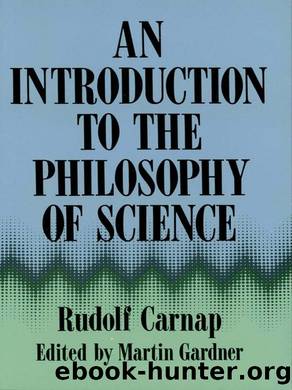An Introduction to the Philosophy of Science by Rudolf Carnap

Author:Rudolf Carnap
Language: eng
Format: epub
ISBN: 9780486140865
Publisher: Dover Publications
Published: 2012-10-13T16:00:00+00:00
CHAPTER 17
Advantages of Non-Euclidean Physical Geometry
IN SEEKING a basis on which to choose between a Euclidean and a non-Euclidean geometrical structure for physical space, there is a temptation at first to choose the approach that provides the simplest method for measuring length. In other words, avoid, as much as is possible, the introduction of correction factors into the methods of measurement. Unfortunately, if this rule is taken literally, the consequences are fantastic. The simplest way to measure length is to choose a measuring rod and to define the unit of length as the length of that rod, without introducing any correction factors at all. The rod, regardless of its temperature, regardless of whether it is magnetized or is acted upon by elastic forces, and regardless of whether it is in a strong or weak gravitational field, is taken as the unit of length. As shown earlier, there is no logical contradiction in adopting such a length unit; nor is there any way in which this choice can be ruled out by observed facts. However, a high price must be paid for such a choice; it leads to a bizarre, incredibly complicated picture of the world. It would be necessary to say, for example, that, whenever a flame is put to the rod, all other objects in the cosmos, including the most distant galaxies, immediately contract. No physicist would want to accept the strange consequences and involved physical laws that would result if this simplest possible definition of length were adopted.
On what basis, then, did Einstein and his followers choose the more complicated, non-Euclidean geometry? The answer is that they did not make the choice with respect to the simplicity of this or that partial aspect of the situation, but rather with respect to the overall simplicity of the total system of physics that would result from the choice. From this total point of view, we must certainly agree with Einstein that there is a gain in simplicity if non-Euclidean geometry is adopted. To preserve Euclidean geometry, physics would have to devise weird laws about the contraction and expansion of solid bodies and the deflection of light rays in gravitational fields. Once the non-Euclidean approach was adopted, there would be an enormous simplification of physical laws. In the first place, it would no longer be necessary to introduce new laws for the contraction of rigid bodies and the deflection of light rays. More than this, old laws governing the movements of physical bodies, such as the paths of planets around the sun, would be greatly simplified. Even gravitational force itself would, in a sense, disappear from the picture. Instead of a âforceâ, there would be only the movement of an object along its natural âworld-lineâ, in a manner required by the non-Euclidean geometry of the space-time system.
Download
This site does not store any files on its server. We only index and link to content provided by other sites. Please contact the content providers to delete copyright contents if any and email us, we'll remove relevant links or contents immediately.
The remains of the day by Kazuo Ishiguro(8790)
Tools of Titans by Timothy Ferriss(8186)
Giovanni's Room by James Baldwin(7164)
The Black Swan by Nassim Nicholas Taleb(6989)
Inner Engineering: A Yogi's Guide to Joy by Sadhguru(6705)
The Way of Zen by Alan W. Watts(6482)
Asking the Right Questions: A Guide to Critical Thinking by M. Neil Browne & Stuart M. Keeley(5601)
The Power of Now: A Guide to Spiritual Enlightenment by Eckhart Tolle(5584)
The Six Wives Of Henry VIII (WOMEN IN HISTORY) by Fraser Antonia(5380)
Astrophysics for People in a Hurry by Neil DeGrasse Tyson(5122)
Housekeeping by Marilynne Robinson(4306)
12 Rules for Life by Jordan B. Peterson(4237)
Double Down (Diary of a Wimpy Kid Book 11) by Jeff Kinney(4182)
The Ethical Slut by Janet W. Hardy(4163)
Skin in the Game by Nassim Nicholas Taleb(4144)
Ikigai by Héctor García & Francesc Miralles(4102)
The Art of Happiness by The Dalai Lama(4051)
Skin in the Game: Hidden Asymmetries in Daily Life by Nassim Nicholas Taleb(3907)
Walking by Henry David Thoreau(3878)
